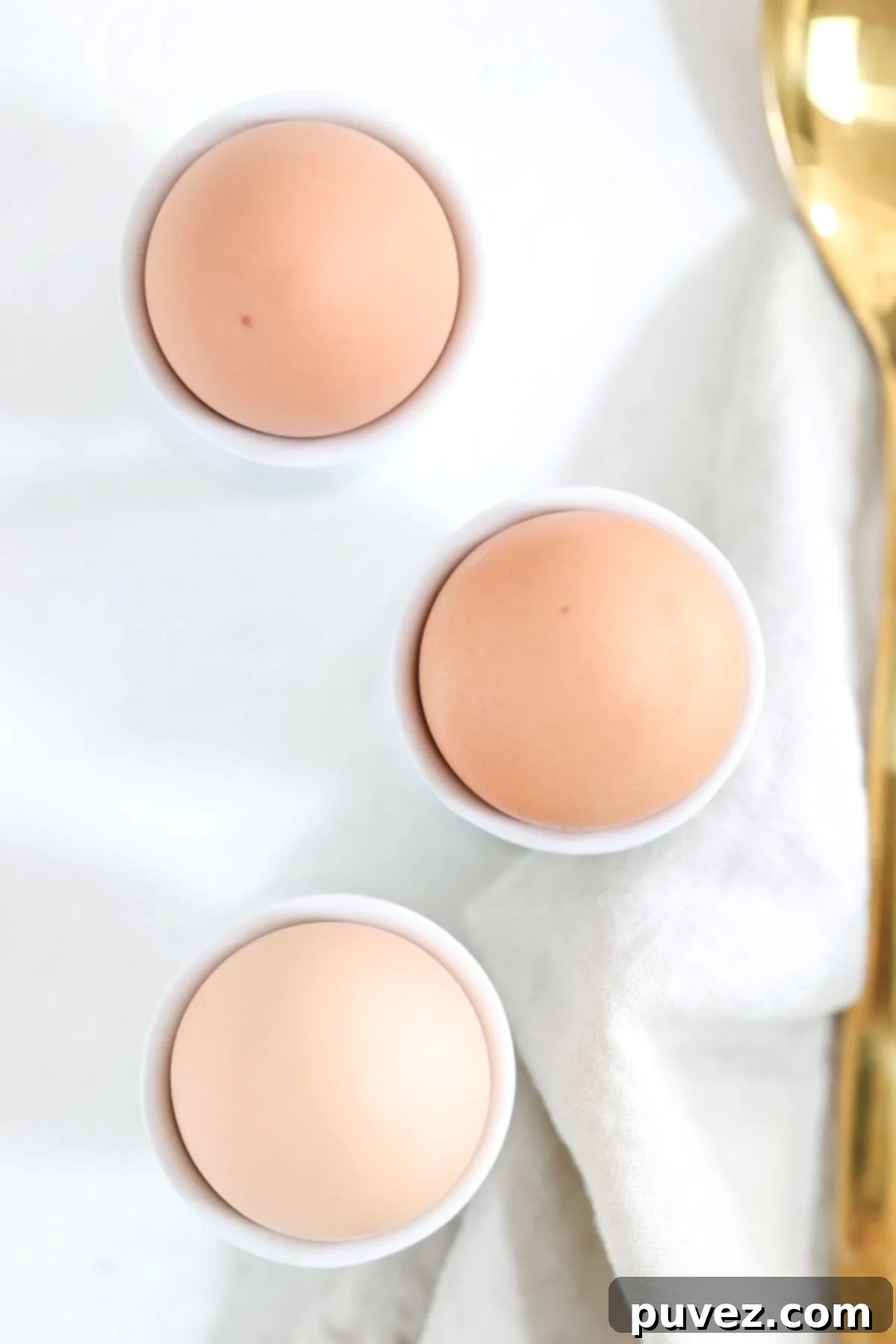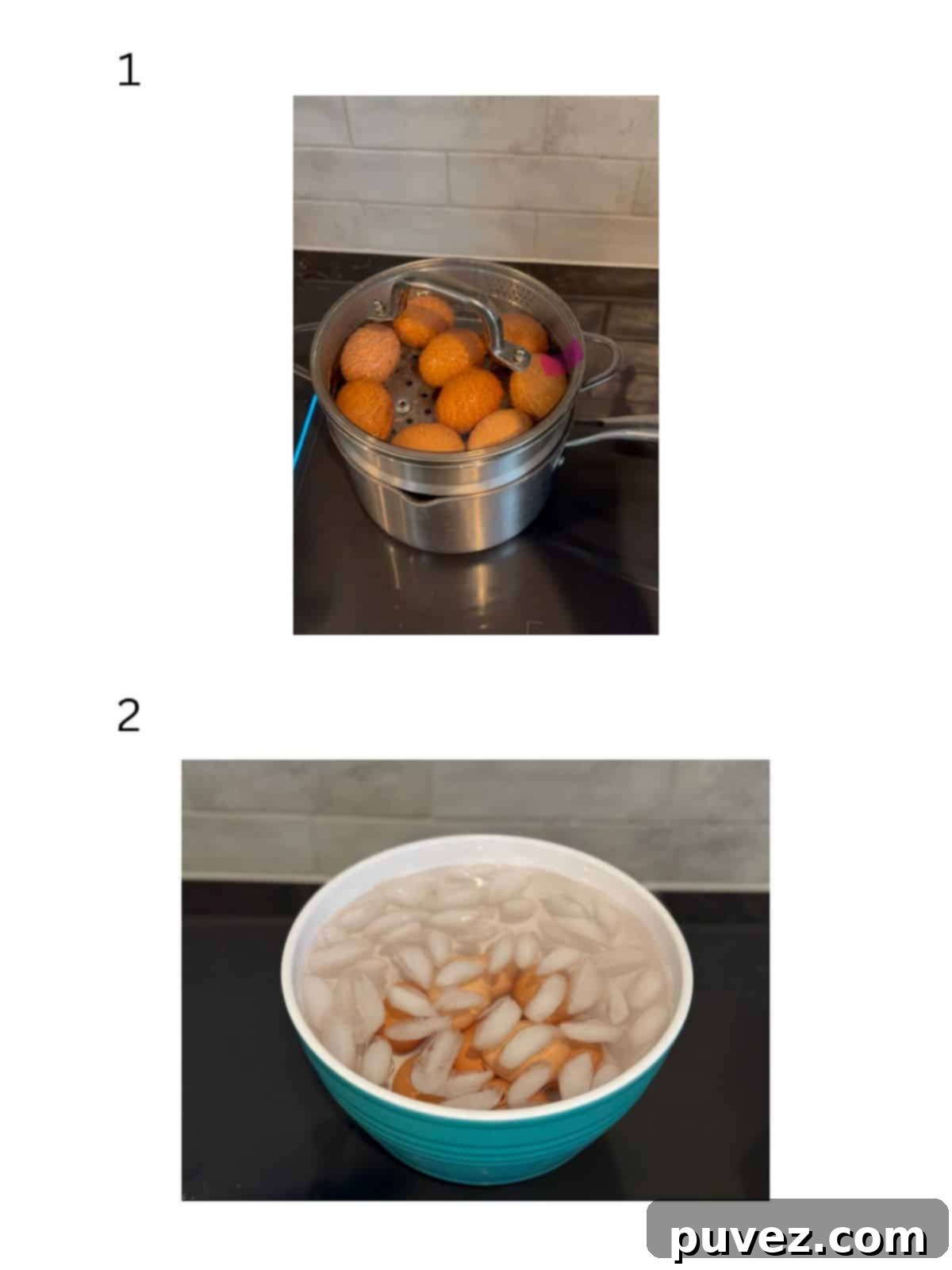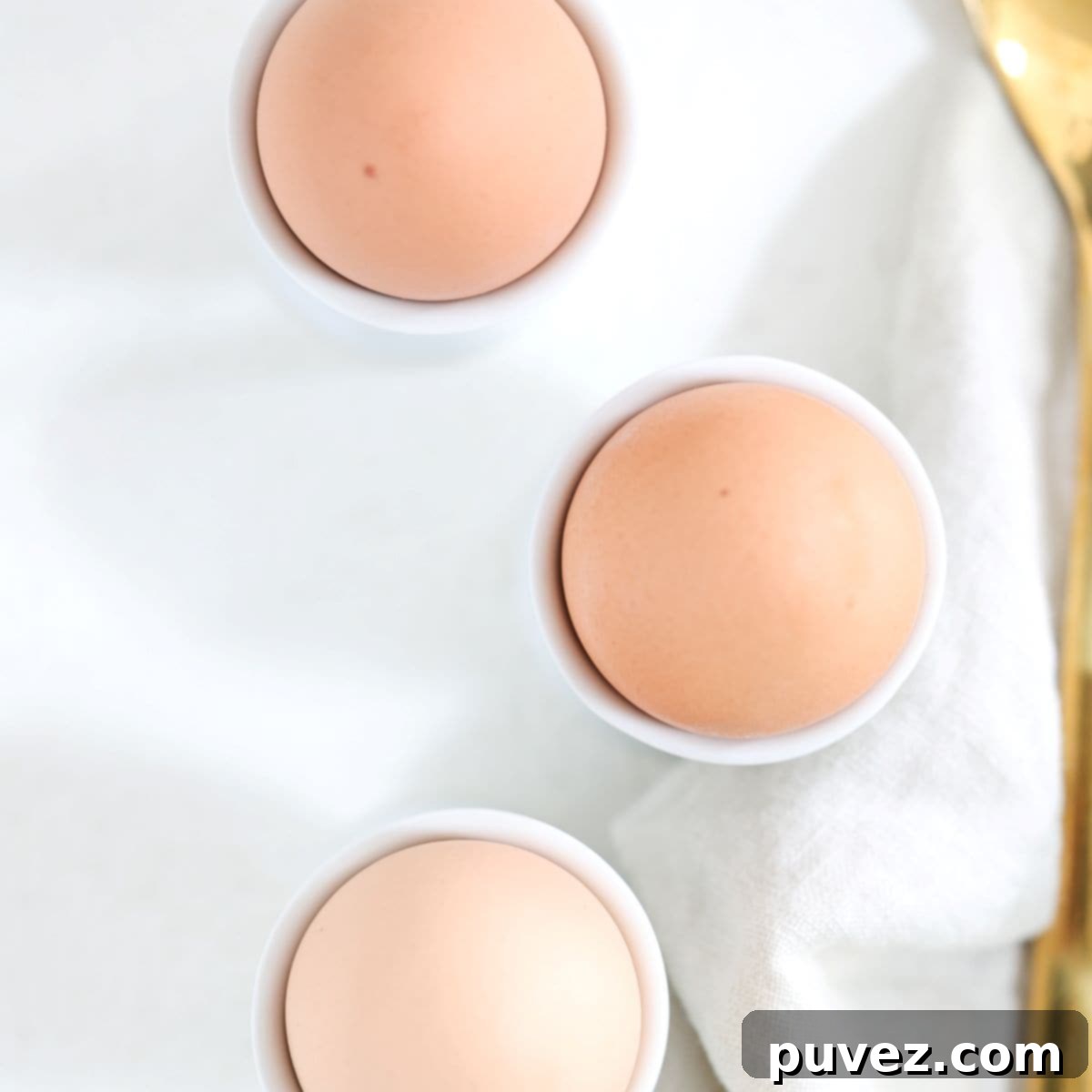Perfect Steamed Hard-Boiled Eggs: The Easy Peel Method You’ll Swear By
If you’ve ever wrestled with a stubborn hard-boiled eggshell, only to lose half the egg white in the process, you know the frustration. Many culinary enthusiasts and home cooks spend years searching for the perfect method to achieve consistently easy-to-peel hard-boiled eggs. The good news? Your search ends here. Once you learn How to Make Steamed Hard-Boiled Eggs and discover just how effortlessly these eggs peel, you’ll wonder why you ever did it any other way!

For over a decade, I’ve been on a mission to perfect the art of making hard-boiled eggs. My husband’s daily request for at least one hard-boiled egg meant I needed a reliable, simple method that consistently delivered easy-to-peel results. The struggle is real when egg whites cling stubbornly to the shell, leading to unnecessary waste. While a few extra minutes for peeling isn’t a deal-breaker, the thought of wasting food certainly is.
Through countless experiments with various techniques – from traditional boiling methods to high-tech gadgets – I’ve discovered a secret that yields perfectly cooked, incredibly easy-to-peel eggs every time: **steaming.** This method is not only foolproof but also remarkably simple, requiring minimal equipment and a short cooking time. The key insights I’ve gathered are to use a pot with a dedicated steamer insert (or a steaming basket), to allow them to steam slightly longer than you might initially think, and surprisingly, to opt for older eggs rather than super fresh ones.
Having our own chickens for years, I can attest that freshly laid eggs are notoriously difficult to peel when hard-boiled, regardless of the cooking method. I’ve tried boiling them in water, and the difference is stark. Fresh eggs simply adhere more tightly to their membranes. This is where the steaming technique truly shines, making even the freshest eggs significantly easier to peel once cooked and cooled properly. Forget the frustrations of ruined egg whites; the steaming method for making easy-peel hard-boiled eggs works flawlessly every single time, proving much simpler than more complex alternatives like an Instant Pot.
[feast_advanced_jump_to]
Why You’ll Love This Steaming Method for Hard-Boiled Eggs
This steaming method isn’t just a slight improvement; it’s a game-changer for anyone who regularly enjoys hard-boiled eggs. Here’s why you’ll fall in love with it:
- Effortless Simplicity: Making perfectly steamed hard-boiled eggs is incredibly easy. All you need are eggs, a small amount of water, and a pot or large saucepan equipped with a steamer insert. The process is straightforward, and once the water reaches a boil, your eggs will be perfectly cooked in just 18 minutes. It truly is one of the simplest and most effective cooking techniques you’ll learn.
- Ideal for Meal Prep: Hard-boiled eggs are a super versatile and nutritious ingredient, perfect for weekly meal prep. They can be safely stored in the refrigerator for up to one week, making them an excellent protein source to have on hand. Prepare a batch of steamed hard-boiled eggs on a Sunday, and you’ll have quick additions for various meals throughout the week. Enjoy them sliced over avocado toast with fresh tomato, mashed into a classic egg salad sandwich, or transformed into elegant deviled eggs for a party appetizer. The possibilities are endless!
- Superior Visual Appeal: One common complaint with traditionally boiled eggs is the unsightly green ring that can sometimes form around the yolk. This discolouration, often caused by overcooking and a reaction between sulfur in the egg white and iron in the yolk, is far less likely to occur when you steam your eggs. Steaming provides a gentler, more even heat distribution compared to direct boiling, which helps prevent overcooking. Furthermore, immediately transferring the cooked eggs to an ice bath halts the cooking process, significantly reducing the chance of that undesirable green ring. The result is a vibrant, perfectly yellow yolk every time.
Dietitian’s Insight: Eggs for Everyday Nutrition
As a busy Registered Dietitian mom, I often find myself scrambling for quick, protein-packed meal options. That’s why hard-boiled eggs are my secret weapon! They are an incredibly versatile and convenient source of high-quality protein, ideal for both kids and adults, especially when time is of the essence.
Eggs are a complete protein, meaning they contain all nine essential amino acids necessary for the body’s growth and repair. This makes them an exceptional dietary choice for building and maintaining muscle, supporting immune function, and promoting satiety. Research, such as studies published in PubMed, consistently highlights the significant nutritional benefits of incorporating eggs into a balanced diet.
Despite their nutritional powerhouse status, hard-boiled eggs are often underestimated, particularly by families with children. However, they can be a fantastic addition to a child’s diet. Some children might prefer just the egg whites, while others will happily devour the entire peeled egg, especially if it’s sliced in half and seasoned with a tiny sprinkle of salt. Offering eggs in different forms or alongside other appealing foods can encourage even picky eaters to enjoy this nutritious food. They’re a simple, affordable, and effective way to boost protein intake for the whole family.
How to Make Perfectly Steamed Hard-Boiled Eggs: Step-by-Step Guide

This quick summary provides the essential steps for making consistently perfect, easy-to-peel steamed hard-boiled eggs. For detailed instructions, precise measurements, and additional tips, please scroll down to the comprehensive recipe card below.
- Prepare the Steamer: Begin by pouring approximately two inches of water into a suitable pot or saucepan. This ensures enough water to generate steam for the entire cooking duration without boiling dry. Next, carefully place a steamer insert or basket that fits snugly inside your pot. Arrange the eggs in a single layer within the steamer basket, leaving a small amount of space between each egg to ensure even steam circulation. Once the eggs are in place, secure the lid tightly. Bring the water to a rapid boil over medium-high to high heat. As soon as the water is boiling vigorously, reduce the heat to medium-high (maintaining a consistent boil) and steam the eggs for exactly 18 minutes.
- Ice Bath Immersion: Immediately after the 18-minute steaming period, it’s crucial to stop the cooking process to prevent overcooking and the formation of a green ring around the yolk. Carefully remove the hot, cooked eggs from the steaming insert using tongs and quickly transfer them into a large bowl filled generously with ice water. Allow the eggs to cool completely in this ice bath for at least 5 minutes. This rapid cooling helps the egg white separate from the shell membrane, making them incredibly easy to peel.
- Peel and Enjoy: Once fully cooled, remove the eggs from the ice bath. You can now effortlessly peel them under cool running water or by gently tapping them on a hard surface to crack the shell before peeling. Enjoy your perfectly cooked, easy-to-peel hard-boiled eggs!
Helpful Tips for Perfect Steamed Hard-Boiled Eggs
Achieving consistently perfect, easy-to-peel hard-boiled eggs often comes down to a few key details. Here are some invaluable tips gathered from years of experience:
- The Age of Your Eggs Matters: In my extensive experience, older eggs are significantly easier to peel than freshly laid eggs. This is due to the pH level of the egg whites. As eggs age, their pH increases, causing the egg white to become less acidic and less likely to bind tightly to the inner shell membrane. Even eggs purchased from a local grocery store, which are typically a few days to a week old, peel beautifully when steamed. However, eggs collected from our own chickens and hard-boiled within a few days of being laid are notoriously difficult to peel, even with this steaming method. Aim for eggs that are at least a week old for the best results.
- Optimal Water Level: The amount of water in your pot is critical. You should ensure there is more than one inch of water, but not so much that it touches the bottom of your steamer basket when inserted. Two inches is a good general estimate. For context, I typically use 2 cups of water when preparing eggs in my 2.5-quart saucepan with a steamer insert. This volume consistently produces sufficient steam for the entire cooking duration.
- Don’t Let the Water Run Dry: It’s imperative that your pot does not run out of water before the 18 minutes of steaming are complete. The boiling water is what generates the steam, which is the sole heat source cooking your eggs. If the water evaporates, the eggs will stop cooking evenly, and you might end up with undercooked eggs or even a scorched pot. Always keep an eye on the water level if you’re using a shallow pot or cooking for an extended period.
- Equipment Size for Batch Cooking: The size of your pot and steamer insert will determine how many eggs you can cook at once. My smaller 2.5-quart saucepan with its steamer insert comfortably holds about 9 eggs in a single layer. For larger batches, I use a larger pot that can accommodate more than a dozen eggs, still ensuring they fit in a single layer without overcrowding.
- Gentle Handling with Tongs: To safely transfer the hot, cooked eggs from the steaming insert to the ice bath, I highly recommend using tongs with silicone heads. The silicone provides a gentle grip, preventing the eggs from cracking or slipping, and protects your hands from the heat.
- Removing from Ice Bath: Once the eggs have completely cooled in the ice bath (typically 5 minutes or more), you can easily remove them using a slotted spoon or even your clean hands. They should be cool enough to handle comfortably.
- Proper Storage is Key: For food safety, hard-cooked eggs should be refrigerated within 2 hours of cooking. Once refrigerated, they are best consumed within one week. Always store them in their shells until ready to eat to maintain freshness and prevent them from absorbing refrigerator odors.
- Consistent Steaming Time: One of the beauties of the steaming method is its consistency. I’ve found that the 18-minute steaming time works reliably whether I’m steaming just seven eggs or a full batch of eighteen. The volume of steam is sufficient to cook all eggs evenly within that timeframe, provided they are in a single layer.
- Sequential Batch Cooking: If you need to prepare multiple batches of hard-boiled eggs back-to-back, it’s essential to reset your pot. Dump out the hot water from the previous batch, add fresh cold water (approximately 2 inches), and restart the process from step 1. While it might be tempting to save time by keeping the water hot, this can lead to overcooked eggs in the subsequent batch due to residual heat and an uneven steaming environment.
- Adjusting for Egg Size: The 18-minute steaming time is optimized for large, extra-large, and jumbo eggs, which are commonly found in stores. If you happen to be cooking super jumbo eggs, you might consider extending the steaming time by an additional two to three minutes to ensure the yolks are fully set. For smaller eggs (medium or small), you might slightly reduce the time, but 18 minutes generally works well for a firm yolk across most common sizes.
Creative Ways to Serve Steamed Hard-Boiled Eggs
Hard-boiled eggs are incredibly versatile and can be enjoyed in countless ways beyond just a quick snack. Their firm texture and rich flavor make them an excellent addition to various dishes. Here are some delicious and creative serving suggestions:
- Elegant Egg Cups: For a charming and simple presentation, especially popular in European cultures like Holland, serve hard-boiled eggs in egg cups. This makes a casual breakfast feel a bit more special and is a delightful way to enjoy a perfectly cooked egg with a sprinkle of salt and pepper.
- Protein-Packed Salads: Transform any side salad into a satisfying meal by adding sliced or chopped hard-boiled eggs. They are a classic component of chef’s salads and are surprisingly delicious when added to Caesar salads. Their creamy yolk and firm white provide a wonderful contrast to crisp greens and other fresh vegetables.
- Classic Egg Salad: A timeless favorite! Finely chop your perfectly peeled hard-boiled eggs and mix them with a small amount of mayonnaise, a hint of Dijon mustard, a splash of apple cider vinegar, and some sweet pickled relish for a delightful crunch. Serve it on toast, in a lettuce wrap, or as a side dish.
- Elevated Avocado Toast: Add a burst of protein and flavor to your breakfast or brunch by topping your avocado toast with mango or tomato with slices of hard-boiled egg. The rich creaminess of the avocado beautifully complements the egg, creating a filling and nutrient-dense start to your day.
- Delicious Deviled Eggs: Also known as filled eggs, deviled eggs are a fantastic appetizer or side dish. Carefully halve the hard-boiled eggs, scoop out the cooked yolks, and mash them with ingredients like mayonnaise, a pinch of salt, black pepper, and perhaps a touch of paprika for color. Spoon or pipe the creamy yolk mixture back into the egg white halves for a crowd-pleasing treat. Try this delicious recipe for Deviled Eggs Without Mustard!
Frequently Asked Questions About Hard-Boiled Eggs
The dreaded green ring around a hard-boiled egg yolk is primarily caused by overcooking. It’s a harmless but unappealing chemical reaction between the iron in the yolk and sulfur in the egg white, creating iron sulfide. To significantly reduce its likelihood, follow these two crucial steps:
1. **Steam your eggs instead of boiling them:** Steaming offers a gentler, more even cooking process, making it harder to overcook the eggs and trigger the green ring formation.
2. **Immediately plunge cooked eggs into an ice bath:** Rapidly cooling the eggs after cooking halts the cooking process, preventing any further chemical reactions that lead to the green discoloration. Ensure the eggs cool completely for at least 5 minutes.
Based on extensive testing and culinary experience, steaming eggs is widely considered the best method for making hard-boiled (or hard-cooked) eggs. This technique stands out because it consistently yields eggs that are remarkably easy to peel, largely due to the gentle cooking process and the way steam interacts with the egg membrane. Additionally, steaming greatly reduces the chances of overcooking, ensuring a perfectly tender white and a vibrant, creamy yolk every time.
Yes, absolutely! It’s very common to overcook hard-boiled eggs, and I’ve certainly done it many times in my culinary journey. An overcooked hard-boiled egg will typically have an unpleasantly rubbery texture in the egg white, and as mentioned, a greenish-gray ring will likely form around the egg yolk. While an overcooked egg is still perfectly edible and safe to consume, its texture and visual appeal will be compromised, making it far less enjoyable to eat. Following the precise steaming times and using an ice bath are key to avoiding this common pitfall.
More Egg-cellent Recipes to Explore
If you love eggs as much as we do, you’ll definitely want to try these other fantastic egg-based recipes:
- Baked Eggs in Muffin Tins: A simple and customizable breakfast for busy mornings.
- Deviled Eggs Without Mustard: A delicious twist on a classic, perfect for those who prefer a milder flavor.
- Green Chile Egg Casserole: A savory and comforting dish with a hint of spice, great for brunches or family meals.
- Air Fryer Breakfast Sandwich: Quick, easy, and perfectly cooked breakfast sandwiches using your air fryer.
Other Useful Culinary Guides
- How to Boil Chicken Breast for Shredding
- How to Pick a Good Pineapple
- 16 Ways to Increase Protein in Smoothies without Protein Powder
- How Many Tablespoons in a Cup
📖 Recipe

How to Make Steamed Hard Boiled Eggs
Kristi
Pin Recipe
Equipment
-
1 saucepan with a steaming insert
Ingredients
- 9 large eggs or however many fit in a single layer in your steaming basket.
- 2 cups water or more, depending on the size of your pot.
Instructions
-
Add about 2 inches of water to your saucepan or pot. For my 2.5-quart saucepan, 2 cups of water is usually perfect.
-
Carefully place the steaming insert into the pan or pot, then gently arrange the eggs in a single layer within the steamer basket. Ensure there’s a little space around each egg for even steam circulation.9 large eggs
-
Cover the pot with a tight-fitting lid. Heat the eggs over medium-high to high heat until the water begins to boil vigorously. Once the water is boiling, immediately set a timer for 18 minutes and reduce the heat to medium-high. The heat should remain high enough to maintain a consistent boil and steady stream of steam.
-
While the eggs are steaming, prepare a large bowl filled with ice water. This ice bath is crucial for stopping the cooking process.
-
When the timer goes off, carefully remove the cooked eggs from the hot steaming insert using tongs with silicone tips. Immediately transfer them to the prepared ice bath and let them cool for approximately 5 minutes. This rapid cooling helps prevent the green ring and makes peeling much easier.
-
Once completely cooled, remove the eggs from the cold water. They are now ready to be peeled and enjoyed!
Notes
- While the eggs are cooking, ensure you have a large bowl of ice water ready. This “ice bath” is critical for rapidly cooling the eggs and stopping the cooking process immediately after they finish steaming.
- For easier peeling, my experience shows that older eggs (typically those purchased from a store, which are a few days to a week old) peel much more easily than very fresh eggs. Eggs laid within a few days from our own chickens are often the hardest to peel, even with steaming.
- Always ensure there’s at least one inch of water in the pot, but ideally around two inches. For reference, when I use my 2.5-quart saucepan with a steamer insert, I typically add 2 cups of water.
- It’s crucial that the water in your pot doesn’t run out before the eggs are fully cooked. The boiling water is what produces the steam necessary to cook the eggs thoroughly. Keep an eye on the water level during the steaming process.
- For optimal food safety, hard-cooked eggs should be refrigerated within 2 hours of being cooked and should be consumed within one week.
- Contrary to some beliefs, I have found that the steaming time of 18 minutes remains consistent whether I’m steaming a small batch of seven eggs or a larger batch of eighteen eggs. As long as they are in a single layer, the steam cooks them evenly.
- If you plan to steam a second batch of hard-boiled eggs immediately, make sure to discard the hot water from the first batch and refill the pot with fresh, cold water. Starting with hot water can lead to overcooked eggs and inconsistent results.
- The cooking time of 18 minutes is generally suitable for large, extra-large, and jumbo eggs. If you are using super jumbo eggs, you might need to extend the steaming time by a couple of minutes to ensure the yolk is fully set.
- I highly recommend using tongs with silicone heads to carefully transfer the hot eggs from the pan to the cold water. This helps prevent cracking and makes handling much safer.
- Once the eggs are completely cooled in the ice bath, use a slotted spoon or your clean hands to remove them from the water.
Nutrition
Tried this recipe?Let us know how it was!
